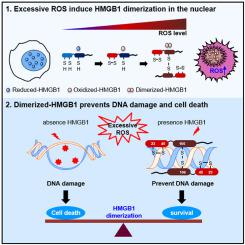Redox Biology ( IF 10.7 ) Pub Date : 2021-01-07 , DOI: 10.1016/j.redox.2021.101858 Man Sup Kwak 1 , Woo Joong Rhee 2 , Yong Joon Lee 3 , Hee Sue Kim 3 , Young Hun Kim 3 , Min Kyung Kwon 2 , Jeon-Soo Shin 4

|
Oxidative stress can induce covalent disulfide bond formation between protein-protein thiol groups and generate hydroxyl free radicals that damage DNA. HMGB1 is a DNA chaperone and damage-associated molecular pattern molecule. As a redox-sensitive protein, HMGB1 contains three cysteine residues: Cys23, Cys45, and Cys106. In this study, we focused on the relationship between HMGB1 dimerization and DNA stabilization under oxidative stress conditions. HMGB1 dimerization was positively modulated by CuCl2 and H2O2. Mutation of the Cys106 residue blocked dimer formation. Treatment of HEK293T cells with CuCl2 and H2O2 enhanced the oxidative self-dimerization of HMGB1, whereas this dimerization was inhibited in mutant HMGB1C106A cells. Furthermore, we performed a bimolecular fluorescence complementation assay to visualize Cys106 oxidation-induced HMGB1 dimerization in live cells exposed to oxidative stress and were able to reproduce the dimerization effect of HMGB1 in fluorescence resonance energy transfer analysis. Interestingly, dimerized HMGB1 bound to DNA with higher affinity than monomeric HMGB1. Dimerized HMGB1 protected DNA from damage due to hydroxyl free radicals and prevented cell death. In conclusion, dimerized HMGB1 may play a regulatory role in DNA stabilization under oxidative stress.
中文翻译:

活性氧诱导 Cys106 介导的反平行 HMGB1 二聚化,防止 DNA 损伤
氧化应激可诱导蛋白质-蛋白质硫醇基团之间形成共价二硫键,并产生破坏 DNA 的羟基自由基。HMGB1 是一种 DNA 伴侣和损伤相关分子模式分子。作为一种氧化还原敏感蛋白,HMGB1 含有三个半胱氨酸残基:Cys23、Cys45 和 Cys106。在本研究中,我们重点研究了氧化应激条件下 HMGB1 二聚化与 DNA 稳定性之间的关系。HMGB1二聚化受到CuCl 2和H 2 O 2的正向调节。Cys106 残基的突变阻止了二聚体的形成。用 CuCl 2和 H 2 O 2处理 HEK293T 细胞增强了 HMGB1 的氧化自二聚化,而这种二聚化在突变的 HMGB1 C106A细胞中被抑制。此外,我们进行了双分子荧光互补测定,以可视化暴露于氧化应激的活细胞中 Cys106 氧化诱导的 HMGB1 二聚化,并能够在荧光共振能量转移分析中重现 HMGB1 的二聚化效应。有趣的是,二聚体 HMGB1 与 DNA 结合的亲和力高于单体 HMGB1。二聚化的 HMGB1 保护 DNA 免受羟基自由基的损伤,并防止细胞死亡。总之,二聚化的 HMGB1 可能在氧化应激下的 DNA 稳定中发挥调节作用。











































 京公网安备 11010802027423号
京公网安备 11010802027423号